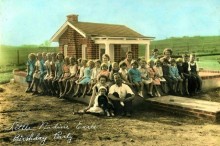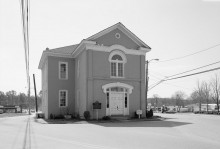AN AUTOBIOGRAPHICAL SKETCH OF SAMUEL FORWOOD
PART II
HARFORD DEMOCRAT
BEL AIR, MARYLAND.
Friday Morning, May 11th , 1888.
A native of Harford County, Md., now a Resident of Gosport, Ala. Written for Preservation in the Archives of the Harford Historical Society.
READ BEFORE THE SOCIETY APRIL 28, 1888.
(continued from Part I)
Wm. S. Hays, who was about my age, and a neighbor and friend of mine, married a lady of Newark, New Jersey, and had made arrangements to move with team, and fifteen or more negroes to Claiborne, Alabama, and proposed to me to accompany him, offering to pay all of my traveling expenses, and to give me at the rate of $200. a year for attending to his business. I readily agreed to accept the offer, and, in the latter part of October, we started on our long journey. At the same time Goldsmith and Henry G. Davis, with team and negroes also, joined our company, and a Mr. Downer, also with team and negroes, fell in with us. Mr. Hays sent his wife and a Miss Robinson out by sea, and at Petersburg, Virginia, he left us and proceeded on horse-back.
Early map of Fort Claiborne in upper right
We arrived safely at Claiborne, Alabama, on the 16th December, 1825, after fifty days travel. We found Mr. Hays, his wife, and Miss Robinson, all there, at the residence of Col. H. H. B. Hays, a brother of Wm. S. Hays, where we were received and treated with the utmost kindness, as were also the Messrs. Davis.
After fixing up Wm. S. Hays on a farm, 10 miles north of Claiborne, on the Alabama, river, I engaged with Col. Hays as clerk in his store until June, I then took a portion of his goods and set up a store on the west side of Alabama river, at a place called Honey Hill, at which place a postoffice was established, and I was appointed postmaster. I boarded with a very good man, Silas Bryan, and did a very good business up to January 1st, 1828. I then settled up satisfactorily with Col. Hays, and engaged passage at Mobile, on schooner ”New York,” for Baltimore. I brought with me Charles Hays, a son of Col. Hays, seven years old; also brought a step-son of Wm. Henderson’s, Julius A. Wood, both of whom were put to school with Rev. Reuben H. Davis, at the Bel Air Academy. We landed in Baltimore in February, 1828, after a voyage of twelve days rough sailing, and reached Bel Air in a few days after. In the following April, I was married, as previously mentioned. We lived with my father until January 1st, 1829, and then settled on a farm, given me by my father, about half a mile from the old homestead, where I remained until the death of my wife, February, 1830. After the death of my wife, Rachel, I broke up housekeeping and lived with my father. My mother had died in 1829. My youngest sister, Julia, was keeping house for my father.
Map of Mobile County, Alabama
I remained there until the fall of 1830, when Col. H. H. B. Hays, of Ala., for whom I had formerly done business, while on his way to New York to purchase a stock of goods, stopped at my father’s to see me, and proposed to me to go with him and join him in business. I felt desolate after losing my wife, and was ready and anxious to go, and therefore at once accepted his proposition. We went by stage-coach by way of Conowingo, Oxford, and West Chester to Philadelphia; thence by steamboat to Princeton, and railroad to New York. We there made our purchases, shipped them, and took passage on ship “Exito” for Mobile, Alabama. After a pleasant passage of eighteen days, we arrived in Mobile, in November, 1830, and shipped by an Alabama river steamboat to Claiborne. I rented a store house at Suggsville, in Clark Co., from John Campbell, and boarded with him. The firm name of the Suggsville store was “Forwood & Hays” and the store at Claiborne was in the name of “Hays & Dupree.” Our business was very satisfactory. John L. Bryan, son of Silas Bryan, was my clerk, and was popular with my customers.
During the summer I bought the estate of Col. Thomas Wiggins, now known as Gosport Landing, on the Alabama river, five miles below Claiborne, and the firm of Forwood & Hays dissolved by consent, and satisfactorily.
Street in Claiborne during 1850s (Alabama Department of Archives and History)
Julius A. Wood had returned to Alabama with me, had become of age, and had received his portion of his father’s estate from Col. Hays, the executor of said estate, and at the desire of his step-father. Mr. Wm. Henderson, we became partners and established a store in the name of ”Forwood & Wood,” at Gosport. A postoffice was also established there at the same time, and I was appointed postmaster, when Wm. T. Barry (?) was the Postmaster-General. At the end year 1832, Wood married and sold his interest out to me, which I carried on until 1839. I then took J. A. Flemming in as a partner, and at the end of the year sold out to him. He managed badly, and I lost largely by him. I took back what goods there were left, and gradually closed up business entirely.
Gov. John Murphy (Alabama Department of Archives and History)
I bought a plantation belonging to the estate of the late Gov. Murphy, on the river, four miles from my residence, and engaged in farming. For a part of the property, 450 acres, I paid $9,000. Eventually, I bought the remainder, two or three thousand acres, at lower figures. Then bought negroes and employed an overseer and went to farming. I was succeeding well in raising corn, cotton, cattle, horses and hogs. At the close of the civil war I had in all about 80 negroes, in the emancipation of which I sustained a loss of about $80,000. I owned some six or seven thousand acres of land. I sold the Gosport Landing tract to pay a security debt for a Sheriff, whose bond I was on. Col. Creagh and myself had to pay $10,000. for the Sheriffs default, and I have in other instances sustained considerable losses by security and otherwise, not necessary to mention here. I still had enough left to give each of four of my sons from six to eight hundred acres of land, retaining the homestead for ourselves, and at our decease to go to our youngest and fifth living son. He, Franklin P., now owns the Murphy plantation, having purchased the interests of his three brothers, William, Samuel and Walter. He now has the property well stocked with cattle, horses, mules and hogs. I will also state that I have just got through paying off all SECURITY DEBTS, some of which have been hanging heavily on me for years, and feel like taking a new start in my old age, should health and strength hold out, but according to nature, that cannot be expected long.
Discordance: The Cottinghams (Volume 1)
Filled with drama, suspense, humor, and romance, DISCORDANCE continues the family saga from the Tapestry of Love series with the children of Mary Dixon who married Thomas Cottingham.
Inspired by true events and the Cottingham family that resided in 17th century Somerset, Maryland, and Delaware, colonial America comes alive with pirate attacks, religious discord, and governmental disagreements in the pre-Revolutionary War days of America.
Orphaned at an early age, the Cottingham siblings face pirate attacks, illness, injuries, and the disappearance of a loved as they try to establish their lives in the wilds of early America. Will they prevail or be torn apart over the issue of slavery?
As in the Tapestry of Love series, the author takes the reader back in time to the beginning days of America. DISCORDANCE: The Cottinghams will appeal to a wide-range audience.







